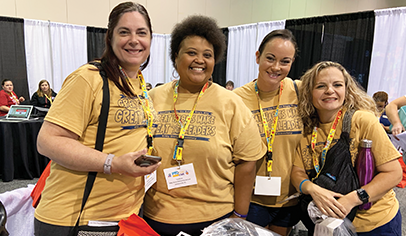It happens in school districts across the country every fall. The first PTO meeting of the year is packed—packed with promise, packed with excitement, packed with attendees. But when the October meeting rolls around, attendance has plummeted. What happened? A bad meeting might be to blame. It doesn’t have to be this way. A well-run meeting can set the stage for a productive school year and it’s easy to pull off if you follow a few simple guidelines.
Watch the Clock (but in a Good Way)
My rule of thumb as a PTO president was to keep meetings to one hour. Period. People are busy. Remember, your meeting is competing with the kids’ homework or the latest episode of Glee. So, you must make it worth parents’ time. Besides, after an hour, meetings hit a point of diminishing returns. People lose focus. They may leave before the meeting ends never to show their face again. Packing everything into 60 minutes isn’t easy, but it can be done. It just requires focus, discipline, and a well-constructed agenda.
Plan the agenda with your time limit in mind and publicize it before the event so everybody will know exactly what to expect. Parents are more likely to go to a PTO meeting when they know ahead of time that they’ll be investing only an hour. And once they’ve gone to your meeting and seen how well run it is, they’re likely to come back for the next one.
Your first agenda item should be to approve the minutes of the previous meeting. Your minutes don’t need to capture every word uttered and by whom; they just need to record decisions and votes. The minutes will refresh everybody’s memory so you won’t have to spend valuable meeting time revisiting everything you covered the last time you met. Ideally, your executive board will have reviewed the minutes via email earlier in the week, making approval a quick and easy process. However, have hard copies on hand to pass out to your general membership.
Steady Ahead
Chairing a meeting requires a mix of firmness and flexibility. The chairwoman’s role is both to keep the meeting on track and to allow attendees to be heard. Designate a spot on your agenda near the beginning of the meeting for “new business/community input.” Keep it to 15 minutes or less—long enough for people to bring up new issues and feel heard.
If the discussion goes on too long, you can politely point out your concern for everybody’s time and move on to the next item on the agenda. If the discussion warrants it, offer to include the topic as an official item on the next meeting’s agenda. As PTO president, I would often make judgment calls to extend a discussion if I felt it warranted more time. But I also wouldn’t hesitate to interrupt speakers who took too much time or started to repeat points. It may seem harsh to say “We’ve heard your point and we need to move on,” but most meeting attendees will be grateful you did.
Be firm about keeping the meeting on topic. It’s the only way to stay within the time limit. It’s also the only way to make progress. When discussing the planned activities for the Polar Express party, don’t allow the discussion to veer off into Family Fun Night. Many meetings get derailed when the board tries to accomplish too much in one session.
It’s also important to be mindful of another common hazard that can keep prospective PTO members away from your meetings: insider discussions. I know about this firsthand because when our PTO met, the board would sometimes be guilty of talking about their own experiences. Yes, the cookie dough fundraiser was a challenge when the dough was delivered three hours late and we had to hand-deliver it to families across town, but it is irrelevant. Save the war stories for social settings.
Likewise, don’t confuse planning sessions with business meetings. Encourage committees to meet separately from the full PTO. A room full of parents looking for updates on the PTO budget and the principal’s school improvement plan do not need to witness a debate over whether to hire a DJ or a live band for the spring formal.
Meet Robert
Finally, familiarize yourself with the basics of Robert’s Rules of Order. A little parliamentary procedure can do wonders when it comes to maintaining order in a meeting. By following basic Robert’s Rules, you can direct your group to stick to one topic at a time. When discussions get off track, suggest that the group table the discussion and revisit it during the appropriate part of the agenda. To discourage side conversations and unproductive back-and-forth debates, remind meeting attendees that comments must be made “through the chair” so you can manage who gets floor time and can cut off discussions that become repetitive and unproductive.
Robert’s Rules are especially important when taking a vote. The meeting chairwoman should introduce the item to be voted on and then ask the group to make a motion. Voting members can either move in favor of or against the item. To be considered, another voting member must second the motion. The chair should then moderate a discussion of the motion and, when there is no further discussion, call for a vote.
If you’re new to Robert’s Rules, they might seem overly strict. But after only a few meetings your group should be comfortable following them. And while these guidelines may seem formal at first, they will save you valuable time and most likely will increase participation levels.
With the help of a well-constructed agenda, Robert’s Rules, and a firm but flexible hand, your PTO meetings will be known as a place where ideas are encouraged, parents are respected, and great things happen.
6 Ways To Make Parents Feel Welcome at a Meeting
1. Introduce the Board
It seems so simple and yet so many PTO boards forget this step. Instead they launch into the agenda without welcoming newcomers or explaining who they are and what position they hold. Share some personal information, too, like how many children you have, what grades they are in, and which teachers they have. After all, you are all parents working toward the same goals, and as a veteran you can be a valuable resource beyond your PTO role.
2. Greet Parents at the Door
It can be intimidating to walk into a room full of strangers who all seem to know each other. Assign a greeter to welcome parents, point out the refreshments, and pass out agendas.
3. Use Name Tags
Introductions are a great first start but new parents have a lot to take in at their first PTO meeting, so use name tags. Have the board wear them as well as the parents. Name tags allow you to address other meeting attendees by name and start forging important relationships.
4. Define Your Terms
Avoid using jargon or acronyms. What is second nature to you sounds like a foreign language to a new parent. The board may know that SEPAC stands for Special Education Parent Advisory Council, box tops are a key fundraising initiative, and A&E means arts and enrichment activities, but no one else will unless you stop and explain. Err on the side of overexplaining. Most new PTO members won’t want to ask questions.
5. Avoid Private Jokes
At my first PTO meeting, the board kept referencing events from previous years and parents by first name only. I felt like I was intruding on a group of friends instead of getting involved in my child’s education. Save the socializing for another time and stick to the agenda.
6. Consider the Seating Arrangement
When I was PTO president, we often had more board members than parents at our meetings. It seemed silly to separate the two groups with a table, so we ditched the traditional meeting setup and sat in a semicircle. The informal setting encouraged participation even though the board overpowered the room.

























